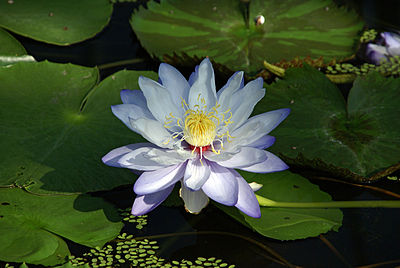Nymphaea subg. Anecphya
| Nymphaea subg. Anecphya | |
|---|---|

| |
| Botanical illustration of Nymphaea gigantea | |
| Scientific classification | |
| Kingdom: | Plantae |
| Clade: | Tracheophytes |
| Clade: | Angiosperms |
| Order: | Nymphaeales |
| Family: | Nymphaeaceae |
| Genus: | Nymphaea |
| Subgenus: | Nymphaea subg. Anecphya (Casp.) Conard[1] |
| Type species | |
| Nymphaea gigantea Hook.[2][3] | |
| Species | |
|
See here | |
Nymphaea subg. Anecphya is a subgenus of the genus Nymphaea.[3][4]
Description
[edit]Vegetative characteristics
[edit]The rhizomes are erect and tuberous.[3] The rhizomes do not produce stolons. The leaves have dentate margins.[5]
Generative characteristics
[edit]The diurnal flowers are large and emergent.[4] In Nymphaea subg. Anecphya s.str. there is a conspicuous gap separating petals from stamens.[4][5] The flowers have up to 600 stamens. The carpels do not have carpellary appendages.[4]
Taxonomy
[edit]Publication
[edit]It was published by Robert Caspary as Nymphaea subsect. Anecphya Casp. in 1888. Later, it was elevated to the subgenus Nymphaea subgen. Anecphya (Casp.) Conard published by Henry Shoemaker Conard in 1905.[6][1] Part of this subgenus was split off by Surrey Wilfrid Laurance Jacobs in 2007 to create the new subgenus Nymphaea subgenus Confluentes S.W.L.Jacobs.[7][4]
Type species
[edit]The type species is Nymphaea gigantea Hook.[2][3]
Species
[edit]- Nymphaea alexii S.W.L.Jacobs & Hellq.
- Nymphaea atrans S.W.L.Jacobs
- Nymphaea carpentariae S.W.L.Jacobs & Hellq.
- Nymphaea elleniae S.W.L.Jacobs
- Nymphaea georginae S.W.L.Jacobs & Hellq.
- Nymphaea gigantea Hook.
- Nymphaea hastifolia Domin
- Nymphaea immutabilis S.W.L.Jacobs
- Nymphaea jacobsii Hellq.
- Nymphaea kakaduensis Hellq., A.Leu & M.L.Moody
- Nymphaea kimberleyensis (S.W.L.Jacobs) S.W.L.Jacobs & Hellq.
- Nymphaea lukei S.W.L.Jacobs & Hellq.
- Nymphaea macrosperma Merr. & L.M.Perry
- Nymphaea noelae S.W.L.Jacobs & Hellq.
- Nymphaea ondinea Löhne, Wiersema & Borsch
- Nymphaea vaporalis S.W.L.Jacobs & Hellq.
- Nymphaea violacea Lehm.
Distribution
[edit]Nymphaea subg. Anecphya has an Australasian distribution.[4]
Ecology
[edit]Habitat
[edit]Species of this subgenus occur in lagoons, lakes, ponds, creeks, artificial dams, and billabongs.[4]
References
[edit]- ^ a b Nymphaea subgen. Anecphya | International Plant Names Index. (n.d.). Retrieved January 23, 2024, from https://www.ipni.org/n/133996-3
- ^ a b Nymphaea subg. Anecphya. (2020, July 13). Wikispecies. Retrieved 18:40, January 23, 2024 from https://species.wikimedia.org/w/index.php?title=Nymphaea_subg._Anecphya&oldid=7603095 .
- ^ a b c d Conard, H. S. (2015). The Waterlilies: A Monograph of the Genus Nymphaea (Classic Reprint). p. 127. USA: FB&C Limited.
- ^ a b c d e f g Löhne, C., Borsch, T., Jacobs, S. W., Hellquist, C. B., & Wiersema, J. H. (2008). "Nuclear and plastid DNA sequences reveal complex reticulate patterns in Australian water-lilies (Nymphaea subgenus Anecphya, Nymphaeaceae)." Australian Systematic Botany, 21(4), 229-250.
- ^ a b null. Nymphaea subg. Anecphya, in (ed.), Flora of Australia. Australian Biological Resources Study, Department of Climate Change, Energy, the Environment and Water: Canberra. https://profiles.ala.org.au/opus/foa/profile/Nymphaea%20subg.%20Anecphya [Date Accessed: 02 February 2024]
- ^ Nymphaea subsect. Anecphya | International Plant Names Index. (n.d.). Retrieved January 23, 2024, from https://www.ipni.org/n/134009-3
- ^ Nymphaea subgen. Confluentes | International Plant Names Index. (n.d.). Retrieved January 23, 2024, from https://www.ipni.org/n/77081992-1

